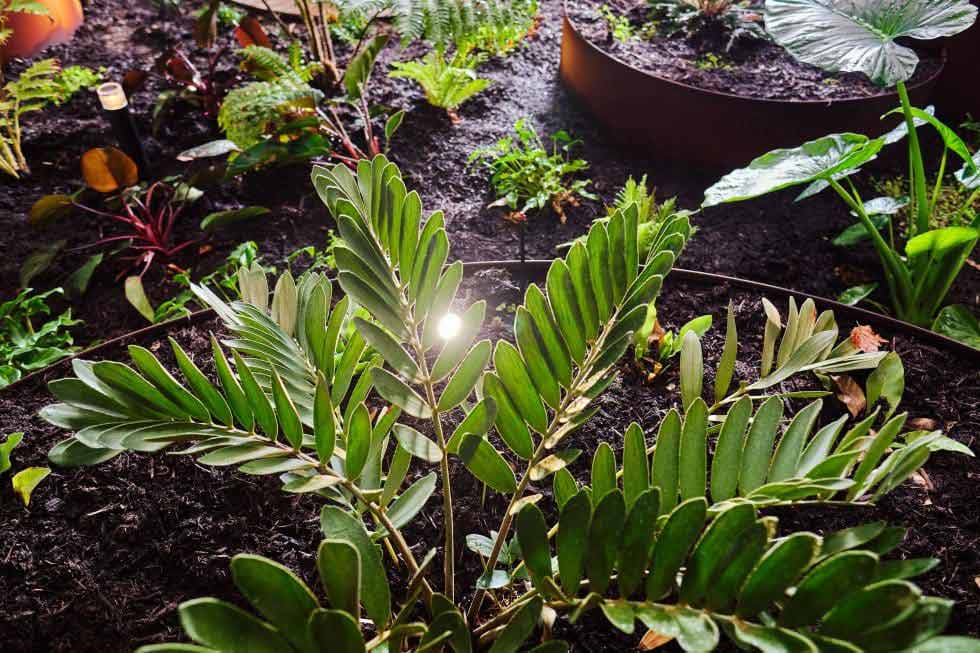You might think it’s not possible to have a tropical garden in Perth – but with the right garden and soil preparation and plant selection, you can have a lush tropical oasis of your very own.
You don’t need a big area to create a lush, colourful tropical garden.
When it comes to creating a tropical garden in Perth, there are a few things you should know first…
How to prepare your garden for tropical planting
A key consideration when planning a tropical garden is that the climate here in Perth is very dry. To create your lush tropical garden, you will need to have a proper irrigation system to enable your tropical plants to thrive. They need much more water than our native plants, and won’t handle drought conditions without help, so adding a carefully designed reticulation system is crucial.
Preparing your soil is the other key element to a successful tropical garden. Here in Perth, we have very sandy soils and sand is not necessarily the best growing medium for most tropical plants. To give them the best chance of first establishing when planted, then thriving for years to come, you will have to carefully improve your soil before planting. This is best to speak to an expert about so they can check the nutrient levels in your soil and apply the right amounts and balance of improvers for the plants you want.
Best tropical garden plants for Perth gardens.
When you know the right tropical garden plants for creating the tropical look in a climate like Perth, your garden will have a better chance of success.
This is why we’ve created a list of low-maintenance tropical garden plants that you can grow in your garden here in Perth.
Blanchet’s Aechmea – ‘Aechmea blanchetiana’
This is quite a large plant and grows a more intense shade of orange depending on the amount of sun it receives.
When it starts flowering, the mother plant begins to die and starts to grow new offsets around the base of the plant. These offsets get their nutrients from the dying plant, and once they grow about a third of the plant, you can replant them in different spaces in your garden.
The leaves have sharp backward-facing spines along their edges, so we recommend using gloves while handling this plant.
When you replant the offsets, take care not to plant them too deep into the soil as this can cause them to die.
Don’t overwater these plants. It prefers dry to damp soil as too much moisture can cause the plant to rot.
Slender Weavers – ‘Bambusa textilis’
Slender Weavers is a type of Clumping Bamboo that has very thick and upright growing canes.
It is ideal for tight spaces and gives you an instant tropical feel while adding privacy because it grows super-fast.
You can plant them on the edge of your garden to get a lush-green privacy screen. It’s the king of screening plants for it can grow up to 6 m in height with full sun or part shade and a splash of water.
Crotons
If you want to focus on adding more color to your garden primarily, crotons are an excellent option.
There are several different species and cultivars, and they are known for their easy maintenance and colorful foliage. They will add a multitude of colors to your garden like orange, red, yellow, and even bright lime green!
If you have a hole in your garden, you can use these shrubs to fill up such spots in your garden.
They require extra care during the winter season as they are frost tender. To protect the roots from cold, mulch with organic materials for at least 2 inches (5 cm) around the plant.
You can also grow them in potted containers so that you can simply keep them inside during the winter until the first warm rays of spring.
Bird of Paradise – ‘Strelitzia’
This majestic plant is well known for its palm-like leaves and vibrant flowers that look like tropical birds when they bloom. As you may have guessed, the flowers are why it gets the name ‘Bird of Paradise.’
It can grow up to 1.3 to 1.5 m tall and spread up to 2 to 3 m.
Strelitzia has three species: reginae, juncea, and nicola; and you can use them all to elevate the beauty of your garden.
Keep the plant in a warm and sunny section of your garden, and only water the plant when the soil feels dry.
One important thing to note is that if eaten, this plant is poisonous to cats and dogs. So if you have a pet who has a habit of chewing your plants, you may not want this in your garden.
Cordyline Palm – ‘Cordyline fruticosa’
It is a perennial, broadleaf evergreen plant that can grow up to 8 to 10 m tall and spread up to 1 to 2.5 m.
It is striking and glossy with streaks of pink, green, purple, and red-colored leaves.
While this plant typically doesn’t bloom indoors, it grows small and fragrant flowers outdoors during the spring. The shade of these flowers ranges from white, yellow, reddish to pale lavender.
Plant it in well-drained soil and water it only when the soil has dried out.
To bring out the intense shade of the leaves, expose the plant to full sunlight.
While those are our best tropical plant suggestions for your garden, here are a few other low-maintenance tropical garden plants you can consider.
- Golden Cane Palm
- Dracaena Marginata (Dragon Tree)
- Sago palm (Cycas revoluta)
- Variegated Ginger
- Hawaiian Hibiscus (Hibiscus rosa-sinensis)
- Alcantarea Giant Bromeliad
- Dancing ladies (Oncidium species)
- Cordyline Fruticosa Rubra
- Cordyline Fruticosa Negra
- Spiral ginger (Cheilocostus speciosus)
- Bromeliad Neoregelia
- Philodendron Xanadu
One thing you need to keep in mind when you are creating a tropical, or any garden, is that you’re also planting for the future, not today.
However lovely it looks now, it will look even more beautiful after it grows into itself and the plants really establish.
Plan out how you will use your space and consider your current lifestyle and budget before you start building your tropical garden.
If you need help with soil improvement or want garden professionals to supply and install your chosen tropical plants, we’d be happy to help.
No idea where to start?
From design to installation, if you need any help building your dream tropical garden, you can find out more and get in touch with us here.

